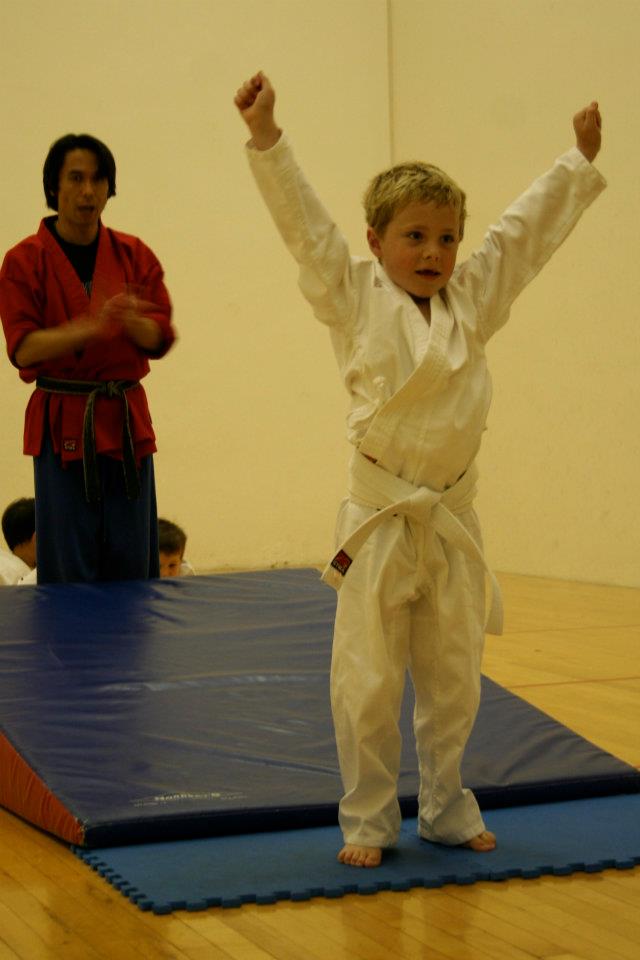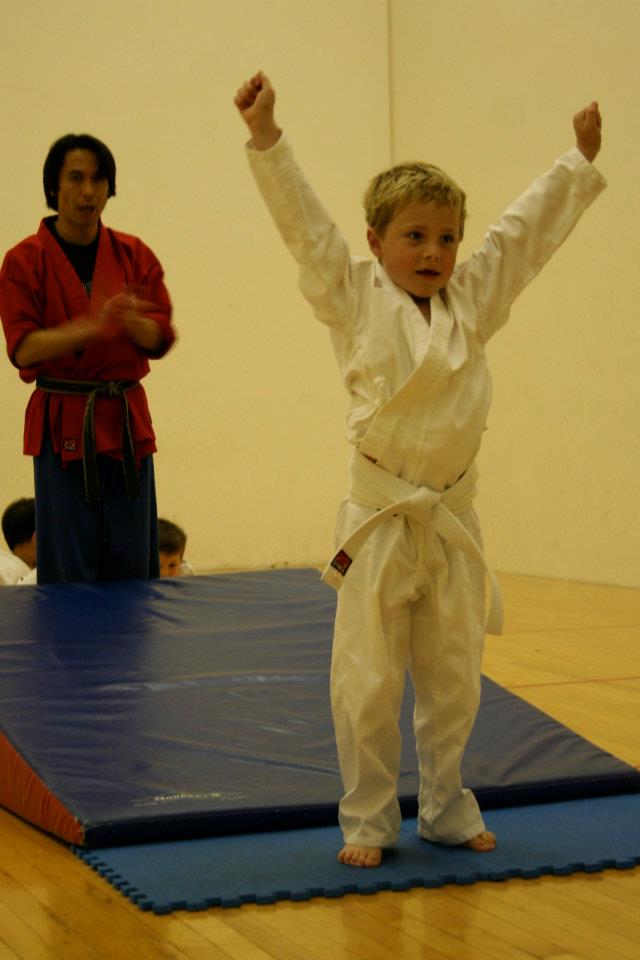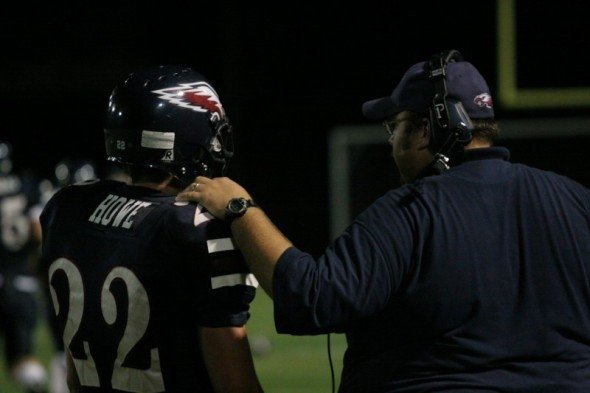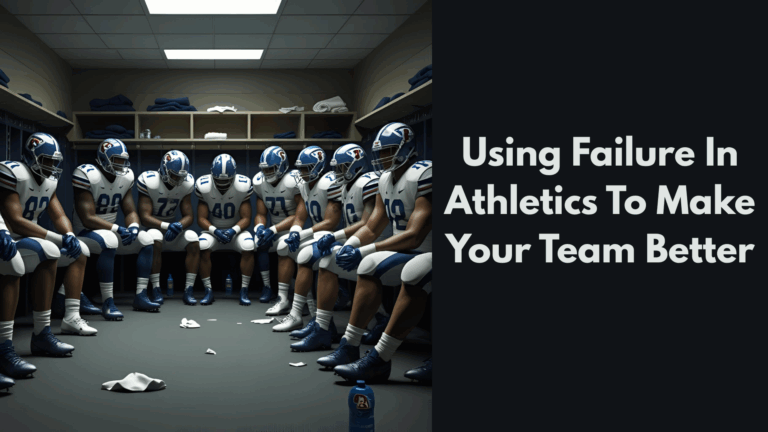
My son's karate instructor is the master at building self confidence in his students. How? He is a great cheerleader. Look at the confidence in my son here, during just his third karate class. He loved his teacher because he was such an encourager.
(This is Part 3 of a Series I’m writing about regarding The Importance of Self Confidence in Athletics. This series stems from a research paper I wrote in 2010 for my Master’s in Athletic Administration and Coaching.)
I strongly believe that Self Confidence is something that should be an instrumental part of a football program yet it is something that most coaches at the high school level tend to overlook (including myself for many years!). Most coaches work hard in the weight room and practice field yet fail to “go to the couch” with their teams, and or they fail to utilize tools to build Self Confidence during their times of practice in the weight room or on the field.
If there was one area of my coaching that I really felt compelled to change during my Sports Psychology (class while earning my Masters) just one piece of sport psychology that I want to walk away with, it was building Self Confidence in my players.

What is interesting is that when I started to implement some of these things I learned in class, we won a League Championship the very next year!
In addition to the empirical research being conducted on the efficacy/performance relationship and sources of self-efficacy, several investigators (Feltz & Doyle, 1981; Feltz & Weiss, 1982) have written articles outlining the importance of self-efficacy and the strategies coaches and teachers can use to enhance it.
Specific techniques recommended by these investigators include:
1. Ensuring performance accomplishments through good instruction
Make sure that your teaching is up to par with what you are asking your players to do. This is where the technical and tactical aspect of coaching becomes important.
2. Setting specific and measurable goals
It’s important that team and individual goals specific, measurable, and attainable. I stole a concept from Concord De La Salle’s football team that I’ve used for the past four seasons. We have the kids make practice and game goals on an index card. Then, they read those goals out at our team meal the night before the game. Then, they choose a teammate or coach to hold them accountable for those goals. It can’t be “I want to practice harder next week.” That isn’t specific and measurable. It needs to be more like “I will practice my long snapping for 10 extra minutes after practice each day.”

3. Emphasizing improvements in technique or process over outcome
Did you get better as a team during the game? Help your coaching staff to measure their success not by the lights of the scoreboard on Friday night but by whether or not your team is becoming a better football team each week. I’ve won some games in my career where we played like donkeys, and had no business winning. And I’ve lost some where we probably played our best game of the year, or as good as we were capable of, just didn’t have the athletes or the luck of the bounce. It’s tough not to be consumed by the scoreboard, but if you want to build self confidence in your athletes, you need to look at other ways to evaluate your success.
4. Liberal use of reward statements
This is something I’ve heard Lou Holtz talk about. He told his coaching staff that they better “say ten positive things for every one negative thing.” I like that. I’ve never practiced that, but what a great goal to have!
5. Verbally persuading athletes
Sometimes we have to just talk athletes up. We have to tell them how good they are, even if they aren’t! I had a kid a few years ago who I just knew was going to be able to play college football. He was that good as a freshman. But he was slow and small. He had no faith in himself at being able to go on to the next level. It took a lot of getting in to this kid’s head before he finally realized maybe he could play college ball. He was able to walk on at a school, and eventually earn a starting receiver spot. Then, they asked him to stay on and coach when he graduated!
6. Encouraging positive self-talk
Some kids these days don’t have a problem with this, but others need to be encouraged to talk positively about themselves. There is a great clip on one of those NFL Films of Bill Parcells teaching a rookie how to field a punt. And he said that one of the keys is to tell yourself, “I’m the best punt returner on the field right now” as you are waiting back there all by yourself.

7. Reducing feelings of anxiety via relaxation training
After I took this class, I’ve done this a few times before games and practices. I turn off all of the lights, have the kids lay down flat and close their eyes. The whole goal is to help them relax. I do a lot of positive team and self talk about the players, and try to paint a picture of the success we will have.
8. Emphasizing that feelings of anxiety indicate not fear but readiness
This is one of those areas where you might need to “put lipstick on the pig!” Kids and coaches will have anxiety before a game. It’s your job to help them focus that anxiety and get rid of it so that they can perform at their highest level. Let them know that they are ready, more ready than they have ever been. The nervous feelings they have 20 minutes before kickoff are just feelings of readiness and adrenaline pumping through their veins!
9. Modeling confidence
I’ve used statements like this before on Monday practice: “I just don’t know . . . . I’m not sure we have what it takes to beat this team . . . . . I think they have better athletes than we do . . . . . . They are definitely faster than us.” What I was trying to do was get the kids ticked off, at the other team, at me, I didn’t care. As long as they were offended, and came together as one to perform. But was I really doing them a service with this kind of talk? Did that model confidence to them? Absolutely not! Now, for me in high school, that would’ve worked. That kind of talk by a coach would have gotten me fired up, where I would want to prove him wrong. It doesn’t work for a lot of kids today! We need to model confidence as a coach, even when we aren’t confident.
10. Using imagery to visualize performance success
See #7, same deal.
11. Employing attributional training (e.g., attributing failure to a lack of effort rather than to low ability).
This really is a key at the high school level. From my experience, at least in the division my teams have been in, there isn’t an overwhelming advantage in size, speed, strength. Of course, one team is usually a bit faster than the other, or stronger than the other, but many times, it’s not ability that wins and loses ball games at the high school level, and obviously that becomes a smaller gap the higher up you go. Many times, I’m convinced of this, it is a lack of effort that loses games.
Therefore, coaches have a variety of techniques or strategies at their disposal to assist in developing self-efficacy in their students and athletes (Beattie, Hardy, Woodman 2004).


